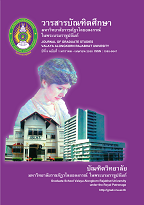หยุดวัฏจักรแห่งความชั่วร้ายของการเมืองไทย STOP POLITICAL VICIOUS CIRCLE IN THAILAND
Main Article Content
Abstract
บทคัดย่อ
บทความนี้ใช้ตัวแบบอำมาตยาธิปไตยของ Riggs เป็นกรอบในการศึกษาพัฒนาการทางการเมืองของไทยตั้งแต่การปฏิวัติเปลี่ยนแปลงการปกครองในปี พ.ศ. 2475 ถึงการทำรัฐประหารของคณะรักษาความสงบแห่งชาติ (คสช.) ในวันที่ 22 พฤษภาคม 2557 โดยมีวัตถุประสงค์ 3 ประการ คือ 1) ศึกษาปฏิสัมพันธ์ทางการเมืองระหว่างพลังระบบราชการและพลังนอกระบบราชการ ซึ่งไม่ว่าฝ่ายใดมีอำนาจในการปกครองมักนำไปสู่วัฏจักรแห่งความชั่วร้าย 2) วิเคราะห์จุดเหมือนและจุดต่างระหว่างการทำรัฐประหาร โดยคณะนายทหารในอดีตกับการทำรัฐประหารของ คสช. ซึ่งนำโดย พลเอกประยุทธ์ จันทร์โอชา และ 3) อภิปรายโอกาสที่ พลเอกประยุทธ์ จันทร์โอชา และ คสช. จะหยุดวัฏจักรแห่งความชั่วร้ายโดยตั้งข้อสังเกตจากการตั้งใจแก้ไขปัญหาต่าง ๆ รวมทั้งการแสดงเจตนารมณ์และนโยบายของ คสช. ที่จะปฏิรูปการเมืองการปกครองของไทยอย่างจริงจัง การศึกษานี้แสดงให้เห็นว่า ตัวแบบอำมาตยาธิปไตยของ Riggs สามารถนำมาใช้ในการวิเคราะห์การมีปฏิสัมพันธ์ทางการเมืองระหว่างระบบราชการกับพลังนอกระบบราชการ ซึ่งช่วยให้เข้าใจการเมืองไทยในปัจจุบันได้อย่างชัดเจน
ABSTRACT
This article studies Thai political development since the Revolution of 1932 until the coup d’état of the National Council for Peace and Order (NCPO) led by General Prayuth Chan-ocha on May 22, 2014. By using Riggs’ Bureaucratic Polity Model, the study has three objectives: 1) Analyzes political interaction between bureaucratic force and extra-bureaucratic force which causes “political vicious circle” as a result regardless of which side assumes the power. 2) Analyzes the similarities and differences between past coup d’état and the present one, and 3) By pointing to the opportunity in which General Prayuth Chan-ocha may succeed in stopping Thai political vicious circle, the study observes the General’s actions an intention to solve national problems including the leader’s will and policy to seriously carry out political reform. Lastly, the study shows that Riggs’ Bureaucratic Polity Model is still useful in helping one to understand Thai politics by observing interactions between bureaucratic forces and extra-bureaucratic forces.Article Details

This work is licensed under a Creative Commons Attribution-NonCommercial-NoDerivatives 4.0 International License.
บทความทุกเรื่องได้รับการตรวจความถูกต้องทางวิชาการโดยผู้ทรงคุณวุฒิ ทรรศนะและข้อคิดเห็นในบทความ Journal of Global of Perspectives in Humanities and Social Sciences (J-GPHSS) มิใช่เป็นทรรศนะและความคิดของผู้จัดทำจึงมิใช่ความรับผิดชอบของบัณฑิตวิทยาลัย มหาวิทยาลัยราชภัฏวไลยอลงกรณ์ ในพระบรมราชูปถัมภ์ กองบรรณาธิการไม่สงวนสิทธิ์การคัดลอก แต่ให้อ้างอิงแหล่งที่มา


